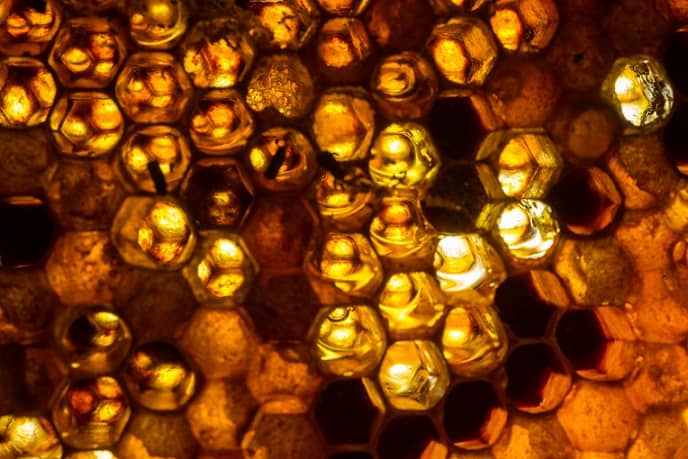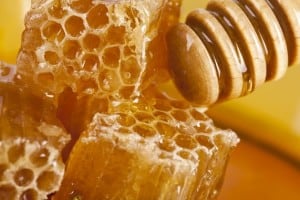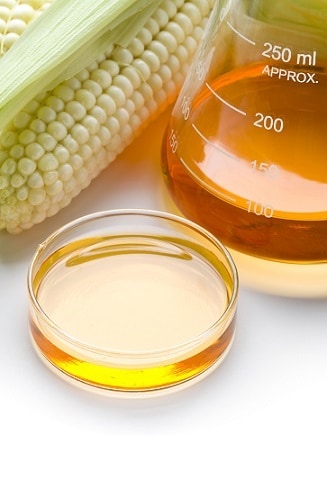 Honey is extremely good at clearing acne, but in the 21st century, honey is also extremely good at being fake.
Honey is extremely good at clearing acne, but in the 21st century, honey is also extremely good at being fake.
According to some people, honey is the world’s third most faked food, and this fakeness isn’t just widespread in third world countries like India or Nigeria. Jars in American supermarkets and on internet websites may consist of honey only as the minority ingredient.
That’s even before considering the small packets of honey served in restaurants. Going to a breakfast diner and picking honey over table sugar for health reasons is just about the worst thing you could do.
Like olive oil, shady third world companies know exactly how closely the word honey is associated with health, and will do anything to exploit it. What would a seasoned mafioso rather do? Would he 1) carefully manage and tend to a colony of bees in order to make honey, or 2) cobble together a recipe of rice, beet and malt syrups, with a tiny amount of regular honey?
The summary of this article is to always buy high quality raw honey, and preferably local honey, but for the full dastardly deeds of the honey industry, keep reading.
The situation on the shelves
The fact is that every single day, people hear on the news about the amazing health properties of honey. They walk to the grocery store, pick a jar off the shelf, and feel optimistic about their future health while vowing to put a spoonful in their coffee every day instead of sugar.
But the reality is that this person probably just bought a mixture of added sugar, artificial colourings, and corn syrup. The product is two steps removed from healthiness – not only is the honey pasteurised rather than raw (and therefore nutritionally dead), but the honey may be just a tiny percentage of the jar.
The stone cold reality is that at least 25% of honey sold in the US could be fake.
Almost no progress has been made over the years. The FDA seizes one massive shipment of fake honey, but the rest continues to flow in. Scientists devise a revolutionary new test to detect fake honey, which crafty criminals bypass instantly. Governments vow a crackdown on fake foreign honey, only to relax import standards again when restaurants and hotels complain.
The FDA has handed out several million dollar fines to US-based honey companies, but in total, the FDA only tests 5% of imported honey.
No pollen = no honey
Take, for example, a Food Safety News study performed in 2011. One of the cornerstone facts about honey quality is that the pollen must be present. Pollen is the best way to identify a honey’s origin, and if the manufacturer has stripped away the pollen, it is clearly trying to disguise something. In all likelihood, the honey has come from China, and may only contain a trace of real honey alongside fillers like corn syrup.
Read Annihilate Your Acne – get the ultimate diet for clear and glowing skin!
Anyway, in 2011, Food Safety News discovered that 76% of all honey products from US grocery stores contained no pollen whatsoever. Likewise, 100 percent of honey from drugstores, 77% from large retail “big box” stores, and 100% of small honey packets from restaurants contained zero pollen.
Meanwhile, every single jar of honey from farmers markets, co-ops and health stores contained the proper amount of pollen.
Food Safety News also contacted 9 different brand names to find out exactly where their honey was sourced from. Each time, the response was almost identical – “we can’t release that information, its properity“. The reason? It doesn’t take a MENSA member to realise that any consumer with an ounce of knowledge wouldn’t like the answer.
Ten years ago, a shipment of Chinese honey infiltrated its way to a warehouse in Houston. By the time the FDA tracked down the honey, it had been resold in 12,040 small packets of honey and 500,000 loafs of bread in US supermarkets.
That was one of the rare shipments which was caught. In 2008, the US government discovered 2500 drums of fake honey in Minnesota, Illinois and Washington state, and arrested two German businessmen for taking part in a global “honey laundering” scheme.
The honey industry is like the wild west even in 2019.
The Chinese connection
All this is made possibly by a insidious supply chain stretching from the USA, though Asian countries and back to the industrial wastelands of China.
Chinese honey has been a hotbed of fraud for two decades now, and in 2002, the EU banned imports of Chinese honey outright. By 2004 though, their dependence was revealed; supplies grew so short that the ban had to be dropped.
In 2001, the US placed large trade tariffs on Chinese honey, but to no avail. In the USA, approximately 50% of honey is imported. 20-25% comes from the trustworthy honey nations of Argentina, Brazil, Uruguay, Mexico and Canada, but nearly 60% comes from shady China.
The simple problem with China is that like with their electronic goods, their honey is designed to make the most money with the poorest possible quality. The Chinese are the masters of adding corn syrup, barley malt sweetener, molasses, and cheap sugar water. The traces of remaining honey are poorly made and nutritionally deprived.
Important article – the top 6 vitamins and minerals for clearing acne
Then there’s the antibiotics they use on the bees, including the toxic chloramphenicol. Chinese honey is even contaminated with heavy metals, as the “honey” is often stored in lead-lined barrels in hot warehouses.
Recently, the sleaziest Chinese producers have perfected their copycat recipe and managed to eliminate real honey entirely. Even today, Chinese honey faces a massive tariff due to this terrible quality, but companies have wormed their way around this by funneling their honey through India or even Australia.
There, they switch the barrels’ colours from blue to green, create fake paperwork, mislabel the country of origin, and continue their massively profitable enterprise. Some claim that the Chinese connection is reinforced by a handful of large US honey buyers, who secretly enjoy the lower prices and therefore keep their mouths shut.
Officially, 45 million pounds of America’s honey comes from India, yet honeybee experts state that India’s capacity is a fraction of that. The conclusion: the honey is funneled from China.
The problem continues to this day; the EU imported 50% of its honey from China in 2014. Central Europe literally lacks enough bees to make honey for itself. In 2014, China was the world’s largest honey producer, making 476,300 tons.
From 2000 to 2014, China’s honey production rose by 88%, yet fascinatingly, their number of beehives rose by just 21%. China’s total bee population is actually falling.
Something doesn’t add up with Chinese honey, yet fast food restaurants serve it every day. Chinese goods are so dodgy that even their eggs can be fake. The whites are made from resin, starch and coagulants, the yolks are made from pigments and different, and the shell is made from calcium carbonate, paraffin wax and gypsum powder, all of which is shoved into an egg-shaped mould.
How honey fraudsters outsmarted scientists
 The bread and butter fraud method is easily diluting the honey with significantly cheaper sweeteners. Honey is expensive, bottles of corn syrup are ten a penny.
The bread and butter fraud method is easily diluting the honey with significantly cheaper sweeteners. Honey is expensive, bottles of corn syrup are ten a penny.
Known ingredients include high fructose corn syrup, beet syrup, rice syrup, sugar water, barley malt sweetener, and jaggery, a traditionally produced cane sugar popular in Asia.
However, the real key to fraudster success is disguising this madness, and here, honey producers are always one step ahead of the government.
A great example is the sugar detection method. In nature, plants can contain different forms of sugar called C3 and C4. All plants have the ancient C3 pathway, but the C4 pathway is only found in tropical plants. Previously, this allowed scientists to detect honey which was diluted with corn syrup or cane sugar, which both increase C4 sugars way too far.
Important article – the top 7 natural topical treatments for acne
The problem is that recently, fake honey producers have unearthed various sugar sources which fit the correct sugar types. Beet syrup and rice syrup have a ratio closer, and are still cheap, and are easy to hide taste-wise.
Consequently, they can bypass the C4 test, meaning that the conveyor belt of fake honey goes on. The honey industry has had the rug pulled from underneath them and have been scrambling unsuccessfully to create another foolproof test ever since.
More tricks of the fake honey trade
Another test used by scientists is for moisture, with pure, raw honey averaging at 17.1%. But another trick of the criminal’s trade is to use drying machines, to bring their honey-flavoured recipe back to passable levels again.
Fraudsters also love to pump up their honey output by overharvesting the honey before it’s properly ripe. Normally, the bees would die, but nowadays, farmers can keep them alive with sugar syrup instead.
The resulting honey is low in the antioxidants and compounds that make it special for acne. It wouldn’t meet the definition of proper honey by any sane definition. The flavour is also missing, but that can be taken care of with artificial flavourings. Some fraudsters only feed bees sugar syrup between flowering, but some are so greedy that they use sugar syrup all year.
Then there’s the most pervasive disguise of all, removing the pollen using ultra-filtration. Removing wax, honeycomb, bee parts and other debris is standard procedure even for raw honey. Pollen removal is not. Scientists have a huge amount of knowledge on analysing pollen to identify the origin of a honey or its plant species – Fraudster Inc. simply can’t allow that.
These tricks happen in China and other third world countries, but the results end up in US towns and cities. The fake honey trade is kind of like the rush to create new legal versions of class A drugs, like LSD and its newfangled analog 1P-LSD, like playing whack a mole or duelling a giant snake with 50 regenerating heads.
Is 80% of manuka honey fake?
All raw honey is filled with bioactive compounds, but manuka honey, honey produced from the manuka flower growing exclusively in New Zealand, is particularly special thanks to its antibacterial compound methygyloxal. Manuka honey is so popular that many UK health shops have to move jars behind the counter to thwart burglars.
But consider the following fascinating statistic. Every year, worldwide sales of jars marked as “manuka honey” are estimated at 10,000 tons. Yet in 2014, New Zealand’s total manuka honey production was just 1700 tons.
Even a toddler could realise that something is amiss there. The demand massively outstrips supply and fraudsters therefore have several tricks. A classic one is substituting manuka honey for its cousin kanuka honey, which is from a closely related plant that lacks any of manuka’s special powers. Kanuka honey tastes surprisingly similar to manuka honey, and its pollen is also similar; both factors make it easy to disguise.
Several years ago, the big honey-testing lab Minerva tested 7 random jars of Manuka honey on UK shelves. Every single one had discrepancies with its label. An even more suspicious 2011 study by the UK Food and Environment Research Agency analysed 23 manuka honey samples and found that 11 lacked the non-peroxide antimicrobial activity (part of methylgyloxal’s powers) which manuka honey is famous for.
Why vitamin C is the acne nutrient you cannot ignore
The easiest trick of all is to slap a number on the jar. Manuka honey is judged by the UMF scale, the “unique manuka factor”, which tells you the strength of manuka’s honey’s unique compounds in that particular jar. Many consumers know about the UMF, but to display a UMF score on your honey jar, you have to register.
Consequently, dishonest manuka companies are displaying random numbers with invented terms like Total Activity 60, or Bioactive 10+, to get approval from customers after a quick glance at the bottle, even though the only terms which have any legitimacy are UMF and MGO (the official methylgyloxal score).
Manuka honey is also riddled with same problems as other honey – diluted with cheaper honey species, cane sugar or even corn syrup.
Manuka honey is the perfect playground for fraudsters because it’s so insanely profitable, being 3 times as expensive as normal raw honey. It’s also very easy to fake; the average health conscious American can’t tell the difference in taste until they gain some experience.
How to defeat the honey fraudsters
 The quickest way to find out whether a jar of manuka honey is legitimate is to scour the UMF register and find the company. Always look for the UMF score and possibly an MGO score on the jar.
The quickest way to find out whether a jar of manuka honey is legitimate is to scour the UMF register and find the company. Always look for the UMF score and possibly an MGO score on the jar.
As for other honey, you cannot beat farmers’ markets, local beekeepers and large, trustworthy brands of raw honey from the internet. Again, the Food Safety News study above found that every honey sample contained the full amount of pollen.
Even if a local beekeeper did have no morals whatsoever, it’s still in his financial interest to make a raw, non pasteurised honey brand, because that’s why local produce is so popular in the first place. The types of people who visit farmer’s markets would sniff out any fakes instantly, and bring their rampaging pitch fork mobs the very next day.
When buying on the internet, there are plenty of reputable brands, but the best solution is simply to inspect and research the reputation of any large brands. Honest Raw Honey, for example, controls every stage of the production, owning the beehives themselves.
The simplest strategy is to read this article, a list of the top ten raw honey brands on the internet.
The only real problem with organic honey is that the species labels are sometimes inaccurate. One study analysed a raw blackberry honey. The honey was as unpasteurised as claimed, but contained a handful of blackberry pollen grains alongside mostly wildflower and clover grains.
Raw honey – a natural secret for wiping out acne bacteria
However, this is more of an accidental discrepancy. If farmers established a dictatorship and controlled every aspect of their honeybees’ lives, it wouldn’t truly be honey any more. The random patterns of flight are vital to producing a complex honey with a flavour influenced by many different plant species, so in this case, local honeybee farmers have to make an educated guess. This is a nitpicking flaw at best; the bioactive compounds are intact.
Here are two useful American links: a national farmer’s market directory, and a national local harvest shop directory.
Conclusion
You might believe that in 2019, honey fraud is a thing of the past. Governments are gaining more and more expertise, fraudsters are scurrying away under a bright light from the media, and the world is becoming safer and friendlier.
But that’s completely incorrect. Snake oil lives on and it probably always will. In all likelihood, the honey-loving Ancient Egyptians of 4000 years ago were scammed as well.
The ultimate solution has to be tracking down a local honey source. Nothing beats having a supply of honey just around the corner.
Just imagine if world war 3, an alien invasion, or a zombie apocalypse broke out. Aloe vera imports would dry up, witch hazel would vanish, argan oil would be no more, and tamanu oil would be stuck on random pacific islands.
Meanwhile, with the rest of the world breaking out in pimples, you would still have a friendly beekeeper with some acne-clearing honey nearby, and you could guarantee that it wasn’t a scam.
NEXT: learn the root causes of acne, clear your skin permanently
Thanks for reading!
